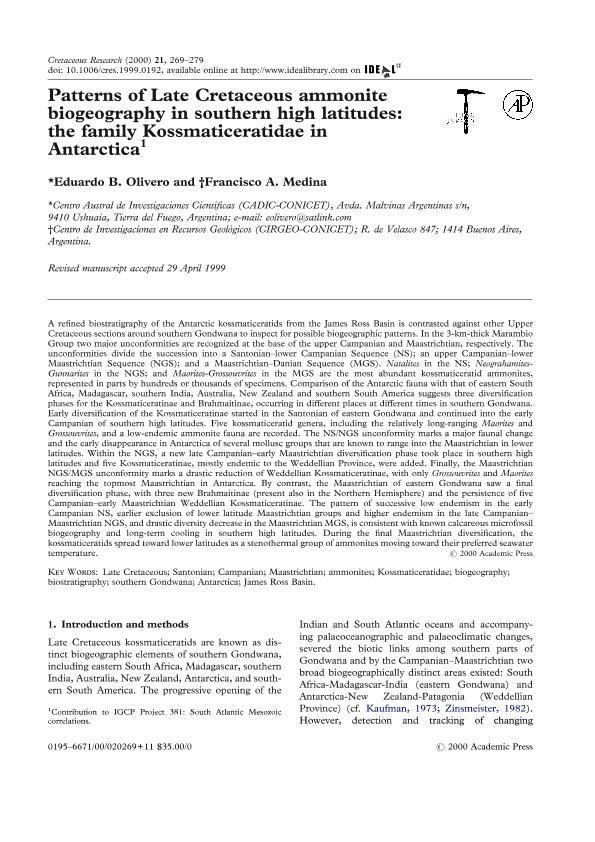Artículo
Patterns of Late Cretaceous ammonite biogeography in southern high latitudes: The family Kossmaticeratidae in Antarctica
Fecha de publicación:
01/2000
Editorial:
Academic Press Ltd - Elsevier Science Ltd
Revista:
Cretaceous Research
ISSN:
0195-6671
Idioma:
Inglés
Tipo de recurso:
Artículo publicado
Clasificación temática:
Resumen
A refined biostratigraphy of the Antarctic kossmaticeratids from the James Ross Basin is contrasted against other Upper Cretaceous sections around southern Gondwana to inspect for possible biogeographic patterns. In the 3-km-thick Marambio Group two major unconformities are recognized at the base of the upper Campanian and Maastrichtian, respectively. The unconformities divide the succession into a Santonian-lower Campanian Sequence (NS); an upper Campanian-lower Maastrichtian Sequence (NGS); and a Maastrichtian-Danian Sequence (MGS). Natalites in the NS; Neograhamites-Gunnarites in the NGS; and Maorites-Grossouvrites in the MGS are the most abundant kossmaticeratid ammonites, represented in parts by hundreds or thousands of specimens. Comparison of the Antarctic fauna with that of eastern South Africa, Madagascar, southern India, Australia, New Zealand and southern South America suggests three diversification phases for the Kossmaticeratinae and Brahmaitinae, occurring in different places at different times in southern Gondwana. Early diversification of the Kossmaticeratinae started in the Santonian of eastern Gondwana and continued into the early Campanian of southern high latitudes. Five kossmaticeratid genera, including the relatively long-ranging Maorites and Grossouvrites, and a low-endemic ammonite fauna are recorded. The NS/NGS unconformity marks a major faunal change and the early disappearance in Antarctica of several mollusc groups that are known to range into the Maastrichtian in lower latitudes. Within the NGS, a new late Campanian-early Maastrichtian diversification phase took place in southern high latitudes and five Kossmaticeratinae, mostly endemic to the Weddellian Province, were added. Finally, the Maastrichtian NGS/MGS unconformity marks a drastic reduction of Weddellian Kossmaticeratinae, with only Grossouvrites and Maorites reaching the topmost Maastrichtian in Antarctica. By contrast, the Maastrichtian of eastern Gondwana saw a final diversification phase, with three new Brahmaitinae (present also in the Northern Hemisphere) and the persistence of five Campanian-early Maastrichtian Weddellian Kossmaticeratinae. The pattern of successive low endemism in the early Campanian NS, earlier exclusion of lower latitude Maastrichtian groups and higher endemism in the late Campanian-Maastrichtian NGS, and drastic diversity decrease in the Maastrichtian MGS, is consistent with known calcareous microfossil biogeography and long-term cooling in southern high latitudes. During the final Maastrichtian diversification, the kossmaticeratids spread toward lower latitudes as a stenothermal group of ammonites moving toward their preferred seawater temperature.
Archivos asociados
Licencia
Identificadores
Colecciones
Articulos(CADIC)
Articulos de CENTRO AUSTRAL DE INVESTIGACIONES CIENTIFICAS
Articulos de CENTRO AUSTRAL DE INVESTIGACIONES CIENTIFICAS
Citación
Olivero, Eduardo Bernardo; Medina, Francisco Alberto; Patterns of Late Cretaceous ammonite biogeography in southern high latitudes: The family Kossmaticeratidae in Antarctica; Academic Press Ltd - Elsevier Science Ltd; Cretaceous Research; 21; 2-3; 1-2000; 269-279
Compartir
Altmétricas




